Joseph Decker (1853–1924) stands as a fascinating, if once overlooked, figure in the landscape of American art, particularly noted for his distinctive still life paintings. Born in the Kingdom of Württemberg, Germany, Decker immigrated to the United States as a teenager, eventually carving out a career that, while not bringing him widespread fame or fortune during his lifetime, has since been recognized for its unique contributions to the still life genre. His work is characterized by an intriguing evolution of style, moving from sharply focused, intensely colored depictions to softer, more atmospheric compositions, reflecting both personal artistic development and broader trends in the art world of the late 19th and early 20th centuries.
Early Life and Artistic Awakening
Joseph Decker was born in 1853 in Württemberg, Germany, into the family of a carpenter. This practical, craft-oriented background may have subtly influenced his later meticulous approach to painting. In 1867, at the age of fourteen, Decker and his family embarked on the transatlantic journey to the United States, a common path for many Europeans seeking new opportunities during that era. They initially settled in Reading, Pennsylvania, before making a more permanent move to Brooklyn, New York. Brooklyn, at that time, was a burgeoning city with a growing cultural scene, providing a stimulating environment for a young man with artistic inclinations.
Before dedicating himself fully to art, Decker engaged in more utilitarian forms of painting. He worked as a house painter and a sign painter, trades that required a steady hand, a good eye for color, and precision – skills that would undoubtedly serve him well in his future artistic endeavors. These early experiences in commercial art provided a practical foundation, even as his aspirations began to turn towards the realm of fine art. By the mid-1870s, Decker had resolved to become a serious artist, a decision that would lead him to seek formal training.
Formal Training and European Sojourn
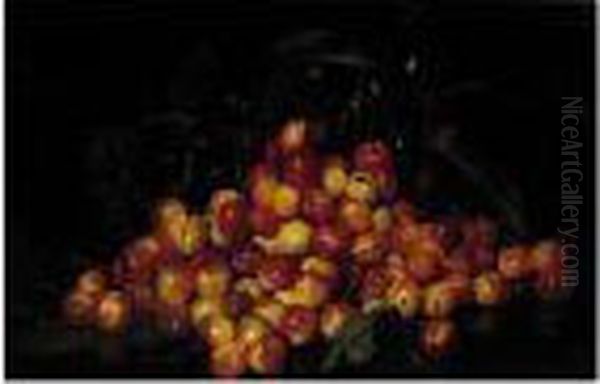
To hone his burgeoning talent, Joseph Decker enrolled at the prestigious National Academy of Design in New York City. The Academy was a cornerstone of artistic education in America, and studying there signified a commitment to academic principles of art. His primary instructor at the Academy was John George Brown, a popular English-born American painter known for his sentimental depictions of street urchins and everyday life. While Brown's subject matter differed significantly from Decker's eventual focus, Brown's emphasis on careful observation and detailed rendering likely played a role in shaping Decker's early meticulous style. During this period, Decker began to exhibit his work, presenting portraits and landscapes at the Brooklyn Art Association, indicating an exploration of different genres before settling on still life.
In 1879, seeking to broaden his artistic horizons and experience European art firsthand, Decker traveled to Munich. Germany, particularly Munich, was a major center for art education, attracting students from across Europe and America. There, he studied for a year under the tutelage of Wilhelm Lindenschmit the Younger, a respected history painter associated with the Munich School. Lindenschmit, himself a student of notable figures, was part of a tradition that valued strong draftsmanship and rich, often dark, palettes. This exposure to the Munich academic style, with its emphasis on realism and technical proficiency, would have further refined Decker's skills, although his own artistic path would diverge from the historical narratives favored by his teacher.
Establishing a Career in America
Upon his return to the United States, Joseph Decker re-established himself in the New York art scene. He resumed exhibiting his work at various prominent venues, including the Brooklyn Art Association, the National Academy of Design, the newly founded Brooklyn Museum, and the Society of American Artists. The Society of American Artists, in particular, was formed by younger artists who often felt that the National Academy of Design was too conservative, suggesting Decker was aligning himself with more progressive elements in the art world, at least initially.
By the mid-1880s, Decker had established his own studio in Manhattan, a clear indication of his professional commitment to his art. This period marked the emergence of his distinctive still life paintings, which began to attract some critical attention. His focus on fruit, often depicted with an almost startling intensity, set his work apart. He was building a reputation, albeit a modest one, within the competitive New York art world.
The Evolution of Style: From Hard-Edge to Atmospheric
Joseph Decker's artistic journey is notably marked by a significant evolution in his stylistic approach, particularly evident in his still life compositions. His earlier works, predominantly from the 1880s, are characterized by a "hard-edge" realism, vibrant, almost jewel-like colors, and a sense of heightened reality.
Early Still Lifes: Intensity and Precision

In his early phase, Decker's still lifes often featured fruit – apples, pears, plums, and berries – rendered with an extraordinary clarity and precision. The forms are sharply defined, the colors are intense and saturated, and there's often a shallow pictorial space with an "unsettling" or unconventional perspective, giving the compositions a modern, almost abstract quality despite their representational nature. Works from this period can feel intensely focused, with each object meticulously detailed, showcasing a remarkable control of the brush.
A recurring and beloved subject in Decker's oeuvre, particularly in this early period, was the squirrel. He reportedly kept a pet squirrel named Bonnie, and these creatures appear in several paintings, often interacting with nuts or fruit. These depictions, like his fruit still lifes, are rendered with the same sharp focus and vibrant color, imbuing these small animals with a lively presence. This early style, with its emphasis on crisp detail and strong local color, has a unique visual impact that distinguishes it from the more conventional still lifes of the time. While not strictly trompe-l'oeil in the manner of contemporaries like William Michael Harnett or John F. Peto, Decker's early works share a fascination with the tangible reality of objects.
The Shift Towards a Softer Aesthetic
Towards the late 1880s and into the 1890s, a noticeable shift occurred in Decker's painting style. He began to move away from the hard-edged precision and intense coloration of his earlier work, adopting a softer, more atmospheric, and tonally subdued approach. This later style is characterized by more blended brushwork, a more muted palette, and a greater emphasis on light and shadow to create mood and volume.
This stylistic transition reflects broader trends in American art, including the influence of Impressionism and Tonalism. The work of the French master Jean-Baptiste-Siméon Chardin, known for his quiet, intimate still lifes and genre scenes rendered with a subtle, painterly touch, is often cited as a significant influence on Decker's later period. Chardin's ability to find beauty in humble objects and his sophisticated handling of light and texture resonated with many artists seeking alternatives to strict academic realism.
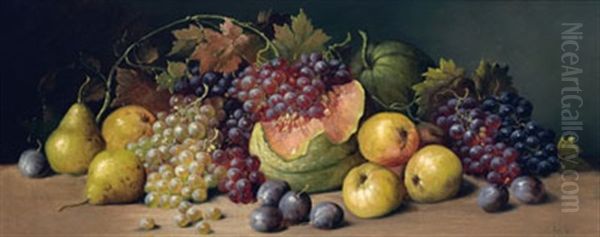
Furthermore, the influence of American Tonalist painters, particularly George Inness, can be discerned in Decker's later landscapes and even in the atmospheric quality of his still lifes. Inness was celebrated for his evocative, moody landscapes that prioritized harmony of color and a sense of poetic suggestion over literal description. Decker's adoption of a softer focus and more unified color schemes in his later work aligns with these Tonalist sensibilities. Artists like Emil Carlsen also explored similar atmospheric qualities in their still lifes around this time, indicating a shared aesthetic current.
Key Themes and Subjects
Throughout his career, certain themes and subjects remained central to Joseph Decker's artistic output, primarily revolving around the natural world, albeit in carefully composed arrangements.
The Allure of Fruit
Fruit was arguably Decker's most consistent subject. His depictions ranged from single, isolated specimens to bountiful arrangements. In his early period, apples and pears often seem to glow with an internal light, their surfaces rendered with an almost tactile reality. He explored the textures, colors, and forms of various fruits with an intensity that suggests a deep fascination with their physical properties. These are not merely decorative arrangements; they often possess a concentrated energy. Even as his style softened, his interest in capturing the essence of fruit remained, though expressed with a more diffused light and gentler transitions.
The Charm of Squirrels and Other Animals
Decker's fondness for animals, particularly squirrels, provided a unique and charming dimension to his work. His paintings of squirrels, such as "The Seated Squirrel" or "Their Winter Hoard," are not just animal portraits but often integrate them into still life compositions with nuts or fruit. These works showcase his keen observational skills and his ability to capture the lively character of these creatures. The inclusion of animals, especially his pet squirrel Bonnie, adds a personal and endearing touch to his oeuvre, distinguishing him from many still life painters who focused solely on inanimate objects.
Notable Works
While a comprehensive catalogue of all his works is extensive, certain paintings are frequently cited as representative of his distinct style and periods.
His early fruit paintings, often simply titled "Apples" or "Pears," from the 1880s, exemplify his hard-edge, intensely colored style. These works are characterized by their sharp focus, vibrant hues, and often unconventional, close-up perspectives that emphasize the sculptural quality of the fruit.
Paintings featuring his pet squirrel, Bonnie, such as "The Seated Squirrel" and "Their Winter Hoard," are among his most recognized and unique contributions. These works combine meticulous detail in rendering the squirrel's fur and alert posture with the rich textures of nuts and autumnal foliage.
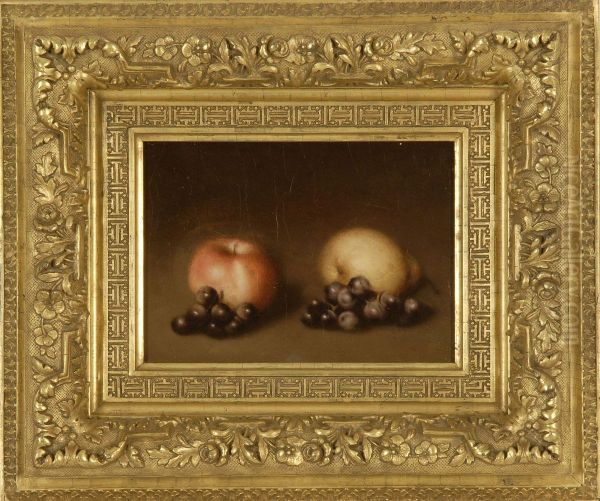
Later works from the 1890s and beyond demonstrate his shift towards a softer, more atmospheric style. While specific titles might be less iconic than his early, hard-edged pieces, these paintings show a mature artist exploring subtleties of light, color harmony, and a more painterly application of pigment, reflecting the influence of Chardin and the Tonalist movement.
Connections and Contemporaries
Joseph Decker's artistic development and career were situated within a vibrant and evolving American art scene. His training under John George Brown at the National Academy of Design placed him within a traditional academic framework, while his studies in Munich with Wilhelm Lindenschmit (whose own lineage traced back to figures like Jean-Léon Gérôme through his teachers) exposed him to European academic methods.
His still life work, particularly the early, highly detailed phase, can be seen in the broader context of American realism that included trompe-l'oeil specialists like William Michael Harnett, John F. Peto, and John Haberle. While Decker's intent may not have been purely illusionistic, his meticulous rendering of textures and surfaces shares a kinship with their work. He also stands in a lineage of American still life painting that dates back to artists like Raphaelle Peale.
The shift in his later style connects him to artists influenced by French Barbizon painting and Impressionism, such as George Inness, and to fellow still life painters who adopted a more atmospheric and tonal approach, like Emil Carlsen. The influence of Jean-Baptiste-Siméon Chardin on this later phase is particularly significant, linking Decker to a revered European master of still life.
The provided information also mentions collaborations or stylistic connections with painters like William H. Michael, and notes similarities in fruit depiction to artists such as William McLaughlin and Levi Wells Prentice (whose detailed fruit still lifes, often in natural settings, were popular). These connections highlight Decker's engagement with the artistic currents and practitioners of his time.
Exhibitions and Affiliations
Joseph Decker was an active participant in the art world, exhibiting his works at several key institutions, which helped to establish his presence, however modestly, among his peers. His affiliations included:
The National Academy of Design: He studied here and later exhibited his works, a crucial venue for artists seeking recognition in 19th-century America.
The Brooklyn Art Association: A significant local institution where Decker frequently showed his paintings, reflecting his strong ties to the Brooklyn art community.
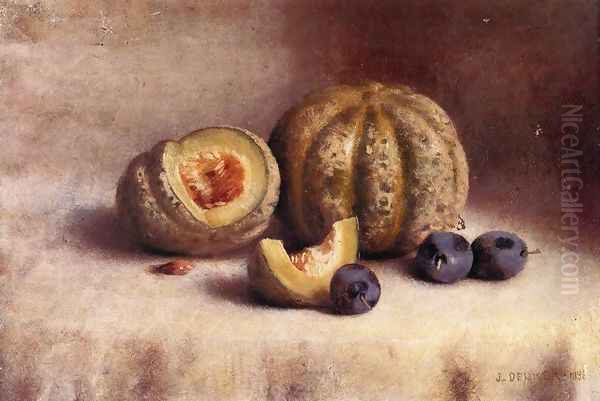
The Society of American Artists: His involvement with this group suggests an alignment with artists seeking newer modes of expression beyond the strictures of the older academic bodies.
The Brooklyn Museum: Exhibiting here further cemented his connection to his home borough.
The Art Institute of Chicago: Showing work at this major Midwestern institution indicates a reach beyond the New York art scene.
These affiliations demonstrate his engagement with the professional art world and his efforts to bring his work before the public and his peers.
Later Years and Posthumous Rediscovery
Despite his talent and consistent production, Joseph Decker did not achieve significant financial success or widespread fame during his lifetime. His later years were spent in relative obscurity in Brooklyn. He continued to paint, adapting his style, but the art market can be fickle, and his work did not capture the sustained attention of major collectors or critics of the day. Joseph Decker passed away on January 4, 1924, in a charity hospital in New York, a poignant end for an artist of such distinct ability.
For several decades after his death, Decker's work remained largely forgotten. However, his artistic contributions were brought back into the light thanks to the efforts of art historian Alfred Frankenstein. In 1949, Frankenstein, a prominent scholar of American art, particularly known for his research on trompe-l'oeil painters, "rediscovered" Decker's work. This led to an exhibition at the Yale University Art Gallery, which played a crucial role in re-evaluating Decker's place in American art history. Frankenstein's scholarship helped to highlight the unique qualities of Decker's still lifes, particularly his early, intense style, and to differentiate him from other still life painters of the period.
Legacy and Conclusion
Joseph Decker's legacy is that of a gifted and individualistic still life painter whose work offers a unique window into the American art scene of the late 19th and early 20th centuries. His stylistic evolution from a hard-edged, vibrant realism to a softer, more atmospheric approach reflects both a personal artistic journey and the broader shifts in aesthetic sensibilities of his time.
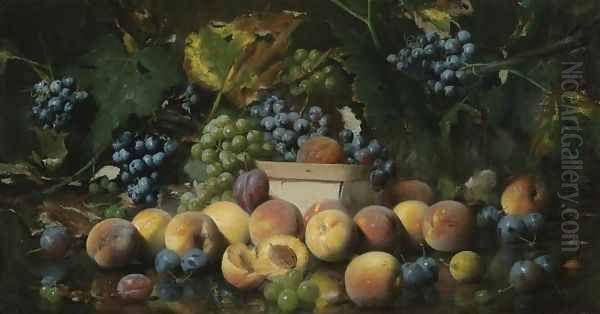
His depictions of fruit, rendered with an almost preternatural intensity in his early period, and his charming portrayals of squirrels, stand out for their originality and technical skill. While he may have been overshadowed by more commercially successful contemporaries during his lifetime, the posthumous recognition of his work, spurred by scholars like Alfred Frankenstein, has secured his place as a noteworthy figure in American still life painting.
Today, Joseph Decker's paintings are appreciated for their distinctive vision, their meticulous craftsmanship, and the intriguing blend of realism and subtle abstraction found in his best works. He remains a testament to the many talented artists who contribute significantly to the richness of art history, even if their fullest recognition comes only in retrospect. His journey from a German immigrant to a dedicated American artist, navigating the changing tides of the art world, offers a compelling narrative of perseverance and unique artistic expression.